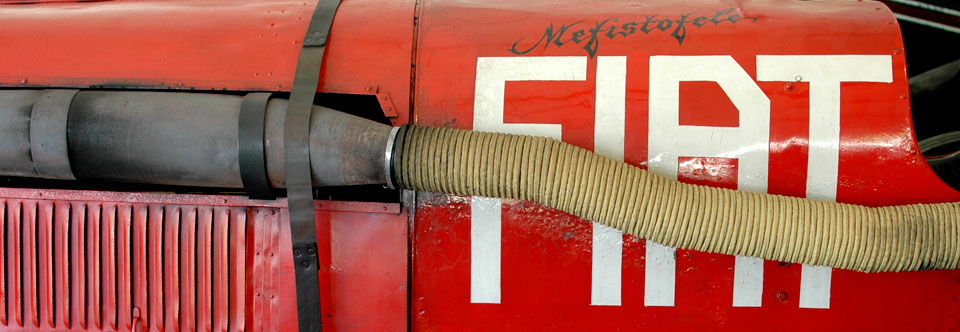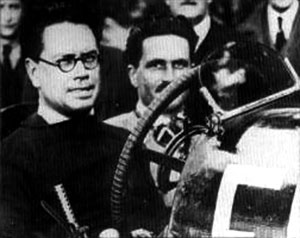
So what is the connection between NS-Class airships and Mefistofele, Sir Ernest Eldridge’s world record racing car? The mighty 21.7 litre Fiat A12 engine.
The Fiat Mefistofele began life as a 1908 Fiat SB 4 chain-driven Grand Prix car, using an engine of no less than 18 litres, with two individual but linked-together cylinder blocks. By 1922 it had come into the hands of John Duff, who was racing it at Brooklands when he became the innocent party in one of the biggest blow-ups ever recorded in the entire history of motorsport. One of the cylinder blocks exploded, separated itself from the rest of the engine, and departed skywards, taking the bonnet and several other supplementary components with it. Duff rather lost interest in the car after that, and went off instead to help start Bentley’s winning run at Le Mans.
The shattered remains of the Fiat were taken over by an amazing character, Ernest Eldridge. He looked at the 18-litre engine and came to the conclusion that it was a little on the small side. It certainly was, in comparison with his current Isotta-Maybach, which had a 20.5-litre Maybach engine insinuated into an extended 1907 Isotta-Fraschini chassis. Eldridge managed to acquire a 21.706 litre six-cylinder A-12 Bis Fiat airship engine. The Fiat A-12 engine was a six-cylinder liquid cooled in-line, single overhead camshaft, engine of 260 horsepower. It was used in such aircraft as the S.I.A. 7B1, Fiat R-2, and S.A.M.L. S-2 reconnaissance aircraft, and the Caproni Ca. 46 bomber. Eldridge was then obliged to lengthen Mephistopheles to accommodate it. The story goes that elements of a London bus chassis were used in the conversion.
The rebuilt car was no crude job, though. It was given rather elegant new bodywork with a shapely tail, and it had the centre line of the front wheels farther ahead of the radiator than any other record car of its day. Eldridge had also breathed on the engine, which, modified with four valves per cylinder, 24 spark plugs – all fired by Magneti Marelli magnetos, but with only two carburettors, now gave a full 320bhp at 1,800 rpm on a 5 to 1 compression ratio. Still chain-drive, of course, no front brakes and two tons in racing trim.
 The vehicle’s 1923 debut at Brooklands saw Ernest Eldridge establish his first 1/2 mile record from a standing start. Soon afterwards, on 12th July 1924 at Arpajon in France, he broke the absolute speed record by achieving a top speed of 146.01 mph. Other records over distances of 5 km and 10 km would follow.
The vehicle’s 1923 debut at Brooklands saw Ernest Eldridge establish his first 1/2 mile record from a standing start. Soon afterwards, on 12th July 1924 at Arpajon in France, he broke the absolute speed record by achieving a top speed of 146.01 mph. Other records over distances of 5 km and 10 km would follow.


 NS11 – As Bright As Day is very much a work in progress and has been made possible by the generous and enthusiastic support of many individuals and organisations. If you have any information, records or material relating to British NS Class airships we would be very interested to hear from you – especially anyone related to members of the crew of NS11 or any airship of the class during their service with the RNAS or RAF during and beyond WWI.
NS11 – As Bright As Day is very much a work in progress and has been made possible by the generous and enthusiastic support of many individuals and organisations. If you have any information, records or material relating to British NS Class airships we would be very interested to hear from you – especially anyone related to members of the crew of NS11 or any airship of the class during their service with the RNAS or RAF during and beyond WWI.
Latest